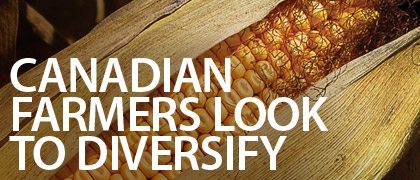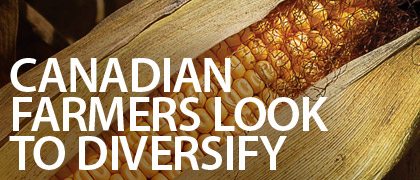
With innovation that’s delivered more early maturing varieties to the market and a changing climate, more farmers consider devoting acres to corn and soybeans.
Farmers have traditionally planted cereals, oilseeds, forages, pulses and potatoes, but the numbers show that the dynamics are beginning to change. Twenty years ago, about 4.4 million acres were planted with corn and soybeans, according to Statistics Canada. This year, it’s reported that nearly nine million acres of corn and soybeans were planted.
While this number is not huge in comparison to canola and wheat, seed companies are taking advantage of new market opportunities as the changing climate, along with faster-maturing seed varieties and new innovations begin to extend the corn belt farther north.
According to Monsanto, increasing crop rotation and moving away from the traditional canola-cereal rotation commonly seen in Western Canada will help improve long-term
rotation sustainability, and the expansion of corn and soybeans into the crop mix will help increase the diversity of western Canadian crop rotations.
Climate Change
While most nations stand to lose with climate change, Canada is predicted to benefit. “It’s a mixed blessing,” says Bob McDonald, a CBC Radio host. “The Arctic region has been warming four times faster than the rest of the planet, bringing about dramatic environmental change, but that same change opens up the North to commerce.”
Growing seasons on the Canadian prairie have lengthened about two weeks in the past half century. Agriculture and Agri-food Canada scientists predict that the mean annual temperature will likely climb by as much as 3 degrees Celsius in the region by 2050. Additionally, the model predicted that precipitation would increase by three to seven per cent. The results suggested that Alberta would benefit the most from increased summer and winter precipitation; however, eastern Saskatchewan and Manitoba would experience little change or smaller increases.
Given these forecasts, the prospect of a Canadian Corn Belt has helped push the value of farmland nationwide up 36 per cent an acre from 2007 to 2012 to $1,926 an acre. Nonetheless, climate change likely means corn and soybeans will continue to creep into the Canadian landscape.
Another reason for the increased adoption of corn and soybean is the availability of more earlier maturing varieties to choose from that consistently yield. In 1994, corn yields across Canada averaged 117 bushels per acre, and this year, they’re expected to average 147.1 bushels per acre — a significant increase. Unlike corn, soybean yields have not increased. Data from Statistics Canada shows soybean yields hovering in the upper 30 bushel per acre range and just entering the 40s during this same time period.
Soybeans have been bred for adaptation to relatively narrow maturity ranges, according to DuPont Pioneer. Varieties in a given maturity group will usually perform as full-season varieties within a 100- to 150-mile band from north to south.
Investments in corn have clearly paid off with respect to yield. Last year, Monsanto Canada announced that it will spend $100 million during the next 10 years to develop corn hybrids with earlier relative maturities as part of a venture called the Canada Corn Expansion Project. Most corn is grown in Ontario and Quebec on about two million to three million acres. As you move into the Prairies, most of the corn is grown in southern Manitoba on about 300,000 acres, but the corn expansion project could result in an estimated annual Western corn market of eight to 10 million acres by 2025, with corn also being grown in Saskatchewan and Alberta.
The Monsanto project is about getting that base maturity lower, says Mike Nailor, Monsanto corn and soybean lead for Canada. The company is working to develop hybrids that will be fully mature in 70 days. Nailor says, in comparison, in the Woodstock area of Ontario, corn matures in 100 days while in southern Manitoba, it’s 76 to 80 days.
He acknowledges that longer growing periods bring higher yields, noting that with a 70-day corn maturity, there will be fewer growing days so farmers aren’t going to get the same yields as Ontarian farmers, who average 150 to 160 bushels per acre. Monsanto is targeting yields of 100 to 110 bushels per acre for its early maturing varieties.
“There are two big things,” says Dan Wright, Monsanto Canadian trait launch lead. “One is investment in breeding and another in working with dealers and growers. We want to provide them with technical knowledge so there’s less risk when they want to introduce corn to their rotations.”
Where’s the Investment in Soybeans?
While soybeans aren’t getting the same kind of investment that corn is, the Canadian government and industry haven’t left it completely out. Earlier this summer, Istvan Rajcan, a University of Guelph professor in the Department of Plant Agriculture, received nearly $2 million in government and industry support to improve soybeans.
Rajcan uses state-of-the art technology to pinpoint genetic markers for producing improved soybean varieties. “We are intent on helping farmers get access to high-performing soybean varieties, and taking a scientific approach,” says Rajcan, whose work will allow growers to select varieties with specific traits, including high yields, protein content, disease resistance and maybe even cancer prevention.
Soybeans are Ontario’s largest cash crop, with farmers planting more than two and half million acres each year worth more than $1.7 billion in 2012. The work of Rajcan and his 15-member research team to increase yields and disease resistance will help make food products and develop varieties with value-added nutritional traits. For example Japanese food producers want soybeans with more sugar. Demand is growing for varieties with more isoflavones, which are linked to reduced risk of cancer and cardiovascular disease.
The work of Rajcan and his team will leave a bigger soybean footprint in the Canadian landscape, but the size is yet to be determined.
Julie Deering













